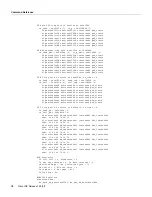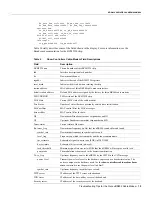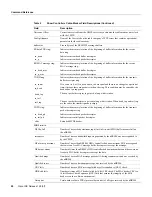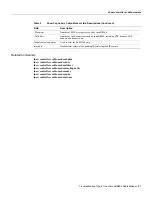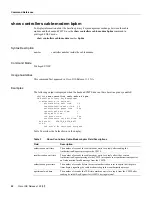
Step 2—Connect to the Cable Modem
Troubleshooting Tips for the Cisco uBR904 Cable Modem 7
.
Step 2—Connect to the Cable Modem
Telnet to the IP address assigned to the cable interface or Ethernet interface. If the interface is not
up, you need to access the Cisco IOS software via the RJ-45 console port, which is a physical port
on the back of the cable modem.
Because the MAC log file only holds a snapshot of 1023 entries at a time, you should try to display
the cable modem’s log file within 5 minutes after the reset or problem occurs.
Table 1
Cable Modem Initialization Sequences and Events
Sequence
Event
Description
1
Scan for a downstream channel and
establish synchronization with the
headend Cisco uBR7246.
The cable modem acquires a downstream channel from the
headend, saves the last operational frequency in non-volatile
memory, and tries to reacquire the saved downstream channel
the next time a request is made.
An ideal downstream signal is one that synchronizes QAM
symbol timing, FEC framing, MPEG packetization, and
recognizes downstream sync MAC layer messages.
2
Obtain upsteam channel parameters.
The cable modem waits for an upstream channel descriptor
(UCD) message from the headend Cisco uBR7246. This is
done to retrieve transmission parameters for the upstream
channel.
3
Start ranging for power adjustments.
The ranging process adjusts the cable modem’s transmit
power. The cable modem performs ranging in two stages:
ranging state 1 and ranging state 2.
4
Establish IP connectivity.
The cable modem invokes DHCP requests to obtain an IP
address, which is needed for IP connectivity. The DHCP
request also includes the name of a file that contains additional
configuration parameters, the TFTP server’s address, and the
Time of Day (TOD) server’s address.
5
Establish the time of day.
The cable modem accesses the TOD server for the current date
and time, which is used to create time stamps for logged events
(such as those displayed in the MAC log file).
6
Establish security.
Keys for privacy are exchanged between the cable modem and
the headend Cisco uBR7246.
7
Transfer operational parameters.
After the DHCP and security operations are successful, the
cable modem downloads operational parameters from a
configuration file stored on the cable company’s TFTP server.
8
Perform registration.
The cable modem registers with the headend Cisco uBR7246.
The cable modem is authorized to forward traffic into the cable
network after the cable modem is initialized, authenticated,
and configured.
Note
The Cisco uBR904 cable modem supports baseline
privacy in Cisco IOS Release 11.3(5)NA and later, and in Cisco
IOS Release 12.0(2)XC and later.
9
Comply with baseline privacy.
Link level encryption keys are exchanged between the
headend and the cable modem.
10
Enter the operational maintenance
state.
As soon as the cable modem has successfully completed the
above sequence, it enters operational maintenance state.


















